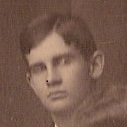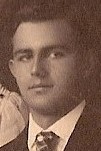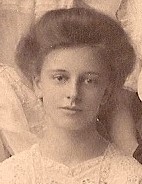
In my last post, we saw that only two women out of seventeen in the Norwalk High School Class of 1907 went on to college, and only one of those two graduated. With the men of the class, however, the story was totally different . Eight of the ten male students in the class went on to college. That disparity tells volumes about the roles of women and men in society, doesn’t it?
Today, we’ll see where these eight men went to college and what they did with their education in their careers.

First up: Sheldon Laning – and here we solve the mystery of who in the class received the scholarship to Ohio Wesleyan University that Arthur Young turned down. It was Sheldon. According to the 1940 Census, he completed four years of college. Not all four years, however, were spent at Ohio Wesleyan. He graduated from Cleveland Law School, now the Cleveland– Marshall College of Law, in 1913. After graduation, he worked in Cleveland, He married in 1915, and moved back to Norwalk in the 1920s to work in the publishing business like his father. [1]
Three graduates attended Western Reserve University, now Case Western Reserve, in Cleveland: Stephen Young, Robert Venus, and Arthur Young.
 Stephen Young went first to Kenyon College, then on to Western Reserve where he graduated in 1911 with a law degree. According to the 1940 U.S. Census, he spent five years in college. He is the most accomplished graduate of the class of 1907. In addition to a successful law career, as a soldier, he served in three armed conflicts: the expedition against Pancho Villa in Mexico and both world wars. He also was elected to many political offices, including the U.S. House of Representatives and the U.S. Senate. [2]
Stephen Young went first to Kenyon College, then on to Western Reserve where he graduated in 1911 with a law degree. According to the 1940 U.S. Census, he spent five years in college. He is the most accomplished graduate of the class of 1907. In addition to a successful law career, as a soldier, he served in three armed conflicts: the expedition against Pancho Villa in Mexico and both world wars. He also was elected to many political offices, including the U.S. House of Representatives and the U.S. Senate. [2]

Robert Venus started at Western Reserve University a year after graduation and according to the 1940 Census, studied there for four years, graduating in 1914. His is an interesting tale. After graduation, he worked as a clerk in Cleveland before serving in World War I. After the war, he moved to Chicago and had a career as an interior decorator. He never married. He returned to Norwalk after retirement, where he again became a clerk, this time at a hotel. [3]

Because Arthur Young led the Class of 1907 academically, he had a choice of scholarships at Ohio Wesleyan and Buchtel College, now part of the University of Akron. Instead, he decided to attend Western Reserve, where he studied for six years. In 1911, he received a Bachelor of Arts degree, magna cum laude, and went on to study law for two more years. After leaving Western Reserve, he married and went to work at the National Bank of Cleveland in the legal department, where he rose to the position of Vice President. Sadly, his career was cut short. In 1943 he suffered a fatal cerebral hemorrhage, becoming the first male graduate to pass away. [4]
Two members of the class of 1907 studied for four years at the University of Michigan: Homer Beattie and Eugene Bloxham.

At the Class of 1907 commencement ceremony at Norwalk High School, Homer Beattie gave an oration on “The Call of the Wild.” Obviously an outdoorsman, he followed his love of nature at the University of Michigan, where he studied forestry. In World War I, he served as a forester in France, then spent much of his career after the war in the Federal Forestry Service. Like Robert Venus, he never married, and also like that classmate, he returned after retirement to the Firelands, where he died of a heart attack in 1950. [5]

Eugene Bloxham studied for four years at the University of Michigan, but did not graduate. He married and lived most of his life in Sandusky, Ohio at an insurance agent. Later in life, he drove a taxi, a step down economically that perhaps was a result of the Great Depression. If that is the case, he would be the only male graduate of the Class of 1907 to have suffered loss from that calamity. [6]

After a year of preparation, Harry Holiday took and passed the entrance exam for Carnegie Technical School, now Carnegie Mellon University, in Pittsburgh, Pennsylvania. The school had been founded by Industrialist Andrew Carnegie to promote the education of manufacturing and research. After he graduated, Harry stayed in Pennsylvania and had a career in management with ARMCO Steel Company, now AK Steel Holding. He retired early, in the mid-1940s, due to a heart condition, and moved to Tucson, Arizona, where he died of a heart attack in 1949. [7]

Finally, Fred French, and another mystery. According to the 1940 Census, Fred had two years of college. I’ve searched every source I can think of, but have not been able to find where he went to school. He married and went to work for Ford Motor Company as an engineer, but his subsequent life was shaped by tragedy. According to his World War I Draft Registration card, by 1917 his wife was crippled, why I do not know. She died sometime after the 1920 Census, and Fred never remarried. He ended his life back in Norwalk, living in his father’s house. [8]
Footnotes:
[1] Sheldon Laning Dies; Prominent City Publisher,” Norwalk Reflector, September 25, 1967, page 2, column 1; U.S. Census Records from 1910, 1920, and 1930.
[2] “Stephen Young” article in Wikipedia.
[3] Western Reserve School Directory of 1909, 1910, 1913; Cleveland City Directory, 1916; U.S. Adjutant General Military Records, 1631-1976, Ohio Soldiers in WWI, 1917-1918; “Obituaries – Robert Venus,” Norwalk Reflector Herald, November 27, 1956, page 16, column 2.
[4] Western Reserve University Yearbook, 1911; “Arthur Young, 53, Born Here, Dies at Cleveland,” The Norwalk Reflector Herald, March 26, 1943, page 8, column 3.
[5] The Michiganensian 1913; Ohio Soldiers in WWI, 1917-1918; “Homer Beattie Passes Away,” Norwalk Reflector Herald, December 13, 1950, page 1, column 5.
[6] Catalogue of Graduates, Non-Graduates, Officers, and Members of the Faculties, 1837-1921. University of Michigan, 1923; U.S. Census: Sandusky, Ohio, 1920, 1930, 1940.
[7] “Candidates for Carnegie School,” Norwalk Evening Herald, June 17, 1908, page 4, column 5; “Harry Holiday, Former Armco Official, Dies,” The Middleton Ohio Journal, April 22, 1949, page 19, column 6.
[8] Records for Fred French are sparse, especially in newspaper archives. What I know about him I’ve gleaned from U.S. World War I and II Draft Registration Card and the U.S. Census for 1920, 1930, and 1940.
Thanks for visiting! Share and like this post below, and on Facebook. Let me know what you think in the comments. I’d love to hear from you!
Filed under: Arthur Young, Demographics, Eugene Bloxham, Fred French, Harry Holiday, Homer Beattie, Norwalk HS Class of 1907, Norwalk OH High School, Norwalk, Ohio, Robert Venus, Sheldon Laning, Stephen Young, Uncategorized | Tagged: Carnegie Mellon University, Cleveland Marshall College of Law, Kenyon College, Norwalk High School, Norwalk High School Class of 1907, Norwalk Ohio History, Norwalk, Ohio, Ohio Wesleyan University, University of Michigan, Western Reserve University | 1 Comment »

















 Stephen Young went first to
Stephen Young went first to 











 The baby of the class was Harriott Wickham (my grandma), who was the only graduate born in 1890. On the first page of her 1909-1910 diary, she wrote that she had started school early, two months before her fifth birthday. I remember her mentioning that to me because I also began school when I was four, although I only had to wait two weeks before my birthday. That wait did not mean much to me back when I was very young. Where my early start really made an impact on me was when I went to college. I was one of the few in my dorm who could not legally drink — at that time in Ohio, you could purchase 3.2% beer at eighteen.
The baby of the class was Harriott Wickham (my grandma), who was the only graduate born in 1890. On the first page of her 1909-1910 diary, she wrote that she had started school early, two months before her fifth birthday. I remember her mentioning that to me because I also began school when I was four, although I only had to wait two weeks before my birthday. That wait did not mean much to me back when I was very young. Where my early start really made an impact on me was when I went to college. I was one of the few in my dorm who could not legally drink — at that time in Ohio, you could purchase 3.2% beer at eighteen.











